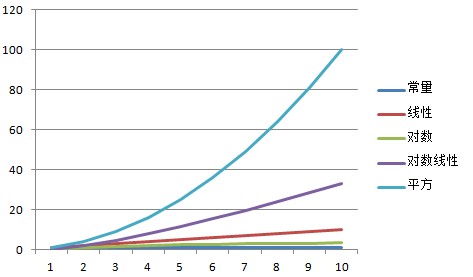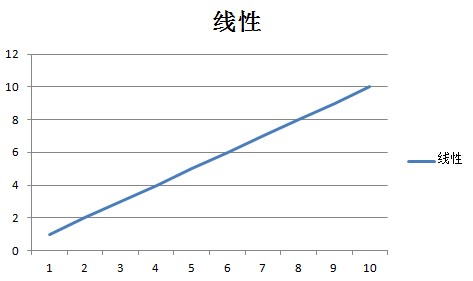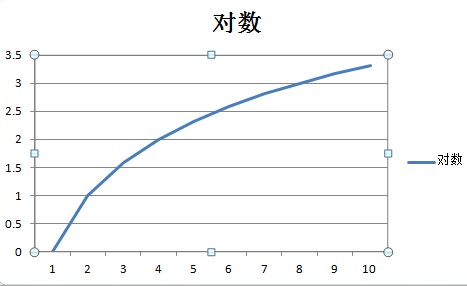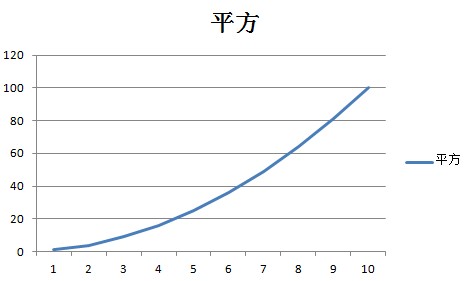算法:Rate of Growth
Rate of growth describes how an algorithm’s complexity changes as the input size grows. This is commonly represented using Big-O notation. Big-O notation uses a capital O (“order”) and a formula that expresses the complexity of the algorithm. The formula may have a variable, n, which represents the size of the input. The following are some common order functions we will see in this book but this list is by no means complete.
Constant – O(1)

An O(1) algorithm is one whose complexity is constant regardless of how large the input size is. The 1 does not mean that there is only one operation or that the operation takes a small amount of time. It might take 1 microsecond or it might take 1 hour. The point is that the size of the input does not influence the time the operation takes.
public int GetCount(int[] items)
{
return items.Length;
}
Linear – O(n)

An O(n) algorithm is one whose complexity grows linearly with the size of the input. It is reasonable to expect that if an input size of 1 takes 5 milliseconds, an input with one thousand items will take 5 seconds.You can often recognize an O(n) algorithm by looking for a looping mechanism that accesses each member.
public long GetSum(int[] items)
{
long sum = ;
foreach (int i in items)
{
sum += i;
}
return sum;
}
Logarithmic – O(log n)

An O(log n) algorithm is one whose complexity is logarithmic to its size. Many divide and conquer algorithms fall into this bucket. The binary search tree Contains method implements an O(log n) algorithm.
Linearithmic – O(n log n)

A linearithmic algorithm, or loglinear, is an algorithm that has a complexity of O(n log n). Some divide and conquer algorithms fall into this bucket. We will see two examples when we look at merge sort and quick sort.
An O(n2)

An O(n2) algorithm is one whose complexity is quadratic to its size. While not always avoidable, using a quadratic algorithm is a potential sign that you need to reconsider your algorithm or data structure choice. Quadratic algorithms do not scale well as the input size grows. For example, an array with 1000 integers would require 1,000,000 operations to complete. An input with one million items would take one trillion (1,000,000,000,000) operations. To put this into perspective, if each operation takes one millisecond to complete, an O(n2) algorithm that receives an input of one million items will take nearly 32 years to complete. Making that algorithm 100 times faster would still take 84 days.
We will see an example of a quadratic algorithm when we look at bubble sort.
Best, Average, and Worst Case
When we say an algorithm is O(n), what are we really saying? Are we saying that the algorithm is O(n) on average? Or are we describing the best or worst case scenario?
We typically mean the worst case scenario unless the common case and worst case are vastly different. For example, we will see examples in this book where an algorithm is O(1) on average, but periodically becomes O(n) (see ArrayList.Add). In these cases I will describe the algorithm as O(1) on average and then explain when the complexity changes.
The key point is that saying O(n) does not mean that it is always n operations. It might be less, but it should not be more.
What are we Measuring?
When we are measuring algorithms and data structures, we are usually talking about one of two things: the amount of time the operation takes to complete (operational complexity), or the amount of resources (memory) an algorithm uses (resource complexity).
An algorithm that runs ten times faster but uses ten times as much memory might be perfectly acceptable in a server environment with vast amounts of available memory, but may not be appropriate in an embedded environment where available memory is severely limited.
In this book I will focus primarily on operational complexity, but in the Sorting Algorithms chapter we will see some examples of resource complexity.
Some specific examples of things we might measure include:
- Comparison operations (greater than, less than, equal to).
- Assignments and data swapping.
- Memory allocations.
The context of the operation being performed will typically tell you what type of measurement is being made.
For example, when discussing the complexity of an algorithm that searches for an item within a data structure, we are almost certainly talking about comparison operations. Search is generally a read-only operation so there should not be any need to perform assignments or allocate memory.
However, when we are talking about data sorting it might be logical to assume that we could be talking about comparisons, assignments, or allocations. In cases where there may be ambiguity, I will indicate which type of measurement the complexity is actually referring to.
算法:Rate of Growth的更多相关文章
- 算法中的增长率(Rate of Growth)是什么意思?
一个函数或算法的代码块花费的时间随输入增长的速率称为增长率. 假设你去买一辆小车和一辆自行车.如果你朋友刚好看到,问你在买什么,我们一般都会说:买小车.因为买小车比买自行车花费高多了. [总花费=小车 ...
- 关联规则算法之FP growth算法
FP树构造 FP Growth算法利用了巧妙的数据结构,大大降低了Aproir挖掘算法的代价,他不需要不断得生成候选项目队列和不断得扫描整个数据库进行比对.为了达到这样的效果,它采用了一种简洁的数据结 ...
- 机器学习(十五)— Apriori算法、FP Growth算法
1.Apriori算法 Apriori算法是常用的用于挖掘出数据关联规则的算法,它用来找出数据值中频繁出现的数据集合,找出这些集合的模式有助于我们做一些决策. Apriori算法采用了迭代的方法,先搜 ...
- FBOSS: Building Switch Software at Scale
BOSS: 大规模环境下交换机软件构建 本文为SIGCOMM 2018 论文,由Facebook提供. 本文翻译了论文的关键内容. 摘要: 在网络设备(例如交换机和路由器)上运行的传统软件,通常是由供 ...
- News common vocabulary
英语新闻常用词汇与短语 经济篇 accumulated deficit 累计赤字 active trade balance 贸易顺差 adverse trade balance 贸易逆差 aid 援助 ...
- [IT学习]微软如何做网站内容治理
How Microsoft does SharePoint Governance for their internal platform english sources from:http://www ...
- RFC 2616
Network Working Group R. Fielding Request for Comments: 2616 UC Irvine Obsoletes: 2068 J. Gettys Cat ...
- 自然数e这家伙怎么蹦跶出来的?
自然数e这家伙怎么蹦跶出来的? 之前看过一篇中文介绍自然数e的blog,引起了我的兴趣 原文是阮一峰大牛(我认为必须很有必要尊敬的称,大牛)嚼烂了吐出来的哈哈,只是我认为还是自己去看原文比較好 感觉非 ...
- 美国政府关于Google公司2013年度的财务报表红头文件
请管理员移至新闻版块,谢谢! 来源:http://www.sec.gov/ 财务报表下载↓ 此文仅作参考分析. 10-K 1 goog2013123110-k.htm FORM 10-K UNIT ...
随机推荐
- CVE-2009-3459
Adobe Acrobat和Reader都是美国Adobe公司开发的非常流行的PDF文件阅读器. Adobe Reader和Acrobat 7.1.4之前的7.x版本,8.1.7之前 ...
- ASP.NET MVC5+ 路由特性
概述 ASP.NET MVC 5支持一种新的路由协议,称为路由特性. MVC5也支持以前定义路由的方式,你可以在一个项目中混合使用这两种方式来定义路由. 案例 1.使用Visual Studio 20 ...
- LoadRunner中的IP欺骗的设置以及误区
LoadRunner中的IP欺骗的设置以及误区 最近在忙着部署web性能测试的环境后,对IP欺骗进行设置,特地做个笔记,给自己的学习历程留下点足迹. 一. 什么是IP欺骗? 做什么事首先要问个为什么, ...
- cent7.0 mysql 修改端口
如何查看mysql 默认端口号和修改端口号 2015-03-19 17:42:18 1. 登录mysql [root@test /]# mysql -u root -p Enter password: ...
- Django实战(22):处理登录和注销
我们已经可以在view函数中判断用户是否已经登录以及获取用户信息: if request.user.is_authenticated(): #判断用户是否已登录 user = request.user ...
- php 生成二维码(qrcode)
可以用composer安装 https://packagist.org/packages/endroid/qrcode
- 人生第一个快速幂的题(HDU - 1097--A hard puzzle )
题意: 最简单的快速幂.给你两个数n和m,求n^m的最后一位: 解题思路: 额,快速幂就很简单了,这里只要最后一位可以一对每次运算都%10: 代码: #include<cstdio> #i ...
- Maven项目使用阿里云的Maven库
Maven项目下载一些jar包非常慢,有时候一个项目能下一个上午,因此可以考虑使用阿里云的Maven库,因为是国内的,所以下载速度非常酷 单个项目使用阿里云的Maven库: pom文件中 <!- ...
- NPE是什么
在编程中出现的空指针异常 Map类集合K/V能不能存储null值的情况,如下表格: remove元素要使用Iterator方式,如果并发操作,需要对Iterator对象加锁. Arrays.asLis ...
- 1017 Queueing at Bank (25)(25 point(s))
problem Suppose a bank has K windows open for service. There is a yellow line in front of the window ...
